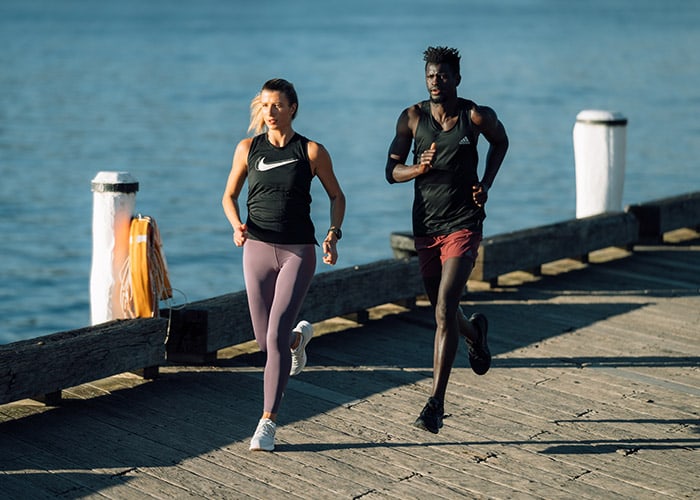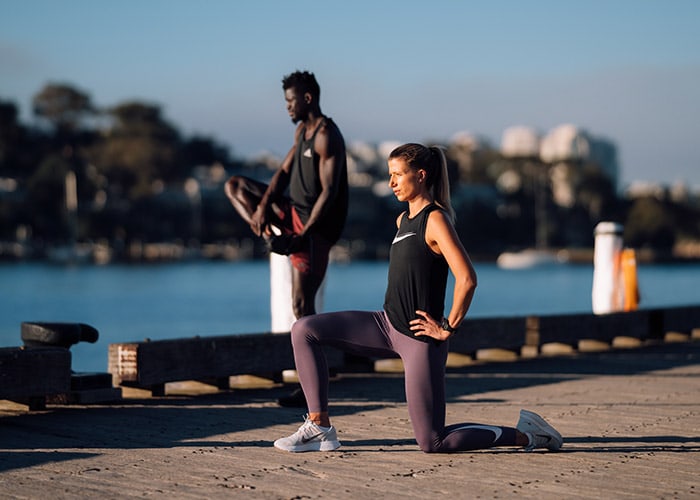Why do people like running? That's the age-old question that many people have tried to answer. We can all remember the days of school athletics and cross country and the feeling of dread at being made to run. Yet, there must be more to running than what meets the eye because so many people lace up their runners and hit the pavement every day. In this article, we are going to be sharing some of our tips and tricks on how to start running and actually enjoy it.
So, you want to start running? Running is an amazing exercise and is one of the world's most popular activities. There are so many benefits to running and almost anyone can do it. All it takes is you, a pair of runners, and the great outdoors. But, why is running so popular and how do you get started?
What Are the Benefits of Running?
Firstly, it's important to understand why people run. There are many reasons why a person decides to run and it's different for everyone. Understanding the 'why' means that you can better understand the motivations, goals, dreams, and passions that people have towards running. The benefits of running include:
1. Fun
Yes, running for fun is a real thing. Running is not just a grueling and painful activity, and many of us will take up running because we genuinely enjoy it. Many avid runners go with a friend or a partner or join a running club to connect with other runners. It's no longer just about fitness, but a great way to enjoy the social time as well.
2. Fitness
The most common reason why people decide to run. Running is a type of aerobic exercise. This means that oxygen is taken into the lungs quickly and exhaled quickly, supporting and building a strong cardiovascular system. Not only this but it helps to strengthen your leg muscles and core, resulting in a stronger and fitter body over time.
3. Destress
Some people run because it allows them to destress from their day. Running helps to reduce the body's stress hormones like adrenalin and cortisone. It also helps promote the production of endorphins, a chemical that is released by the brain to help elevate mood and reduce pain. Because running is a full-body workout, the number of endorphins released by the brain can account for something commonly known as the runner's high. This is the feeling of euphoria and weightlessness experienced after a long run.
4. Cheap
Running is a great way to have a solid workout without the excessive cost of a gym. You just put on your shoes and go. It's basically free and only requires willpower and determination to see it through.
5. Personal goals
Many people run to achieve personal goals. For some, running is an efficient way to lose weight. For others, they want to meet a certain distance or time, or pace. People might also run to train for events, like a marathon or fun run. There's something about the feeling of getting outside, feeling those trainers pound the concrete underneath you, getting amongst nature, and experiencing the rush of adrenalin when you push yourself harder, faster, and longer.
Whether it's for fun, to achieve a goal, or for better health, once you've figured out your own reason to start running, staying motivated and sticking to it won't seem like a chore.

What Running Gear Do You Need?
We all know how tempting it can be when we start a new activity to go out and purchase all the fancy gear and equipment. But what do you really need to start running?
1. Shoes
Basically, when you first start out you should focus on getting a really good pair of running shoes. Running is a great form of exercise; however, it can be very taxing on the body. As a beginner, your body is going to have to adapt to the impact of running, especially your feet, shins, and calves. Don't go for any shoes that aren't designed for running, like basketball shoes or sneakers. These types of shoes don't have enough support and cushioning to properly protect your feet.
Professionally fitted running shoes will provide the correct support for your natural gait and reduce your chance of injury, while also making a huge difference to your form, speed, and the health of your legs when you start pounding the pavement.
Need help choosing the right shoes for you? Our guide is bound to help.
2. Clothing
Clothing is very subjective when it comes to exercise because it all depends on you and what you feel comfortable in. When it comes to running, having a decent pair of shorts or running tights that are comfortable and fit properly as well as a t-shirt is all you need to start. Our Leggings & Tights guide will help you choose the right style and fit for you.
Get into the rhythm of running and how it feels first. Once running becomes part of your routine and you want to stick to it, then invest in nicer activewear. But at the start, don't focus too much on what you're wearing and focus on the running.
You could also try wearing compression socks while running. Compression socks are great because they help with reducing the amount of swelling and joint pain during and after a run. The added compression will ensure you are ready for the next training run with reduced soreness.
3. Gadgets
If you are running to achieve personal goals, like weight loss or for an event, then investing in a gadget, like a fitness watch, is a great way to measure your goals and better achieve them. When you run, a fitness watch can track a multitude of factors like steps, distance, heart rate, calories, etc., and can really benefit the user in tracking their progress long term.
Fitness watches can sync to your mobile device or laptop, so all the information is stored digitally and can be accessed easily. It is not necessary to have a fitness watch to start running, however, they are a great investment if you are looking to track certain metrics and goals.
Check out our guide to help you choose the right sports watch for your activity.
When & Where to Run
Now, there's a lot of speculation when it comes to when to run and where. For a beginner, there are a few methods we would recommend you start with:
How often should you run?
As we have previously mentioned, running can take a toll on the body when you first start. There is a lot of impact that your body has to get used to and you will probably experience muscle soreness and fatigue when you first start.
For beginner runners, we recommend running around 2-3 times a week, depending on your fitness level. This means you can give your body enough time to rest and recover between runs, resulting in a better recovery rate and hopefully resulting in less injury. Once you feel stronger and fitter, you can up your runs to 3-4 times a week and increase other factors like time and distance to meet your new fitness level.
What time of day is best for running?
In terms of when to run during the day, it all depends upon the individual runner. Some of us early birds enjoy running in the morning because it gets it over and done with before work. It can make you feel refreshed and jump-starts your metabolism.
Other runners feel more energetic running after work in the evenings or use it as a way to de-stress after a long day. It also means that you don't have to wake up earlier, which is a bonus.
Where can you run?
When it comes to deciding where to run, there are a variety of places and surfaces to choose from, that all feel different for your body and your fitness level. As a beginner, we recommend starting to run on a running track or a paved pathway. This kind of surface is the smoothest and best for beginners because it allows your body to adjust to the new strain on an even surface.
However, if you're finding that a paved surface is still too hard for running and you need to run on something softer, you can try running on the grass at a park or a sports field. This will allow your legs and feet to slowly adjust to the pressure and impact of running while giving them a softer and less taxing surface. Be careful though, as some parks or sporting fields can have uneven surfaces, so just be cautious when running on these surfaces.
Once your fitness and expertise increase, then you can start running on uneven surfaces, like outdoor tracks and the beach.
Mapping your running route
You should also try to map your runs before you head out the door. Having a solid understanding of your route, how long, and for what distance will give you a sense of accomplishment and it will also allow you to track your progress as you get fitter and stronger. There are plenty of fitness apps that will track your runs for you, but you can also try and use different indicators to track your routes like a specific tree or a street sign.
Don't Forget to Stretch and Recover
Always make sure, even if you're a beginner or an expert runner, to stretch before and after every run. Stretching is so important for the body because this will help to prevent injury. After a run, your muscles and joints are warm and therefore more pliable. Taking the time to properly stretch will increase your flexibility and ability to recover faster.

Running is a great sport to get into. Not only is it amazing for your health and physical appearance, but it will help you to destress and unwind after a stressful day. Remember, don't give up after your first attempt. The truth is running can be an acquired taste – the more you run, the more you will grow to enjoy it. Learning to run and enjoying running may take some practice, but once you get the hang of it, you'll be able to answer the question of 'Why do people love running?'
But wait, there's more! Continue to Beginner's Guide to Running: Part 2.
Shop our entire range of running and fitness gear at rebel now.